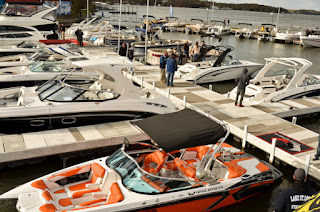Life Jackets Why Wear One... It will Save Your Life.
How many adults wear life jackets, when then are out boating? be honest now. We make our children wear them, why not the adults?
Missouri's state law is Children under seven years old are required by law to wear a PFD while aboard any vessel, unless they are in a totally enclosed cabin, such as on a houseboat. Before heading out, make sure the life jacket fits the child well, so he or she won't slip out of it after falling into the water.
Children ages one to four have the highest drowning rates. Drowning is responsible for more deaths among children one to four than any other cause.
According to the Missouri State Highway Patrol, Missouri has averaged more than 46 non-boating related drownings per year on streams, rivers, ponds and lakes, over the past five years. These numbers do not include drownings that occurred in swimming pools. As of May 2019, there were seven fatality drownings this year. There were a total of 34 drownings in 2018, 59 in 2017 and 38 in 2016.
Drowning ranks fifth among the leading causes of unintentional injury death in the United States. Nearly 80 percent of people who die from drowning are male. Majority of the drownings are adult males.
When I give boating lessons, and ask an adult if they want to have a lifejacket, the most common answer is I can swim, don't need one. If you are injured or unconscious, you can not swim.
The U.S. Coast Guard received reports for 4,604 boating incidents; 3,153 boaters were reported injured, and 672 died. Most (72 percent) boating deaths that occurred during 2010 were caused by drowning, with 88 percent of victims not wearing life jackets. Air-filled or foam toys, such as “water wings,” “noodles,” or inner-tubes, are not good substitutes for life jackets.
Life Jackets have came a long way
Life Jackets have changed sense the Titanic. Life jackets are now more user specific. There are life jackets for Wave Runners, kayakers, general boating, for pets. So how do you pick the right life jacket?
If you are concerned that the life jacket would be to hot or restricting, consider inflatable type. They provide the comfort and freedom provided by a suspender-style inflatable PFD. At the opposite end of the spectrum, “float coat” jackets combine flotation with the insulation of a jacket when it’s cool. They’re a favorite of fishing enthusiast
As Discover Boating suggests " Life jackets, life vests, ski vests…they’re all common names for PFDs, or personal flotation devices. Their job, as the names imply, is to keep the wearer alive and afloat should they unexpectedly end up in the water or elect to participate in watersports such as skiing or wake surfing. Although the goal might be simple, life jacket styles, fit and method of use can all affect whether your PFD does the job it’s intended for.
Here’s a guide to selecting, fitting and using various life jackets, vests and PFDs.
How to Choose the Right Life Jacket
- Select the proper type based on activity or boating conditions.
- Check for a proper fit.
- Examine the outlined size and weight requirements.
- Ensure the life jacket is in good condition—look for holes and tears.
- Don't forget to wear it.
Select the Proper Life Jacket Type
Personal flotation devices come in various types, and ideally should be chosen to best match your activity or boating conditions.
- Type I jackets offer the greatest buoyancy (over 20 pounds) and are designed primarily for offshore use. They’re bulky to wear but have the distinct advantage of turning an unconscious person face up in the water.
- Type II jackets are likewise designed to turn an unconscious person face up in the water. They offer a minimum 15.5 pounds of buoyancy and are typically chosen for nearshore boating excursions. Though not exactly fashionable, their inexpensive price and often simple construction make Type II life jackets a longstanding favorite for boaters looking to satisfy U.S. Coast Guard safety requirements.
- Type III jackets likewise offer 15.5 pounds of buoyancy. Often referred to as “ski vests,” their comfortable, formfitting style makes them an excellent choice for watersports as well as general passenger use. Type III jackets typically feature a front entry and buckle, or buckle-and-zipper closure. The catch with Type III jackets is that they are designed for conscious wearers with an imminent chance of rescue; a Type III jacket is not guaranteed to turn an unconscious wearer face up in the water. Type IV personal flotation devices are designated as “throwables,” and typically take the shape of a ring or flat cushion that can be thrown to a person who lands unexpectedly in the water.
- Type IV PFDs are designed to be held onto, rather than worn, by the user. They offer a minimum 16.5 pounds of buoyancy. Tip? Though some might look the part, don’t use a designated throwable as a seat cushion. Over time, the practice will degrade the foam and reduce the amount of flotation.
- Type V jackets are special-use PFDs, often combined into flotation coats, whitewater rafting vests, even sailboard harnesses. They should be used only for their intended purpose.
Once you select the proper type of PFD for your conditions and/or activity, make sure it is in good condition, with no holes or tears, and fits properly. A jacket that is too large can slip off the wearer. One that is too small might not offer sufficient buoyancy to keep the wearer afloat.
- Look for the manufacturer’s labeling that details the size and weight the jacket is intended to fit.
- Once you have the proper size, put on the jacket, fasten any closures (buckles, zippers, etc.), then lift your arms up straight over your head and ask a friend grab the top of the jacket above the arm openings and pull upward.
- Ideally, the jacket should not rise any higher than the wearer’s chin. If it rides up as high as the ears, it’s too large and could slip off in the water; size down to get the proper fit.
- Don’t overlook the crotch strap found on life jackets designed for young children. This additional strap runs between the legs from the back of the jacket to the front and offers added assurance the jacket will not ride up or slip over a child’s head.
80 percent of the drowning victims were found not wearing a life jacket.
That’s why the best life jacket available just might be the one you’re willing to wear…every time you’re out on the water.






Comments
Post a Comment